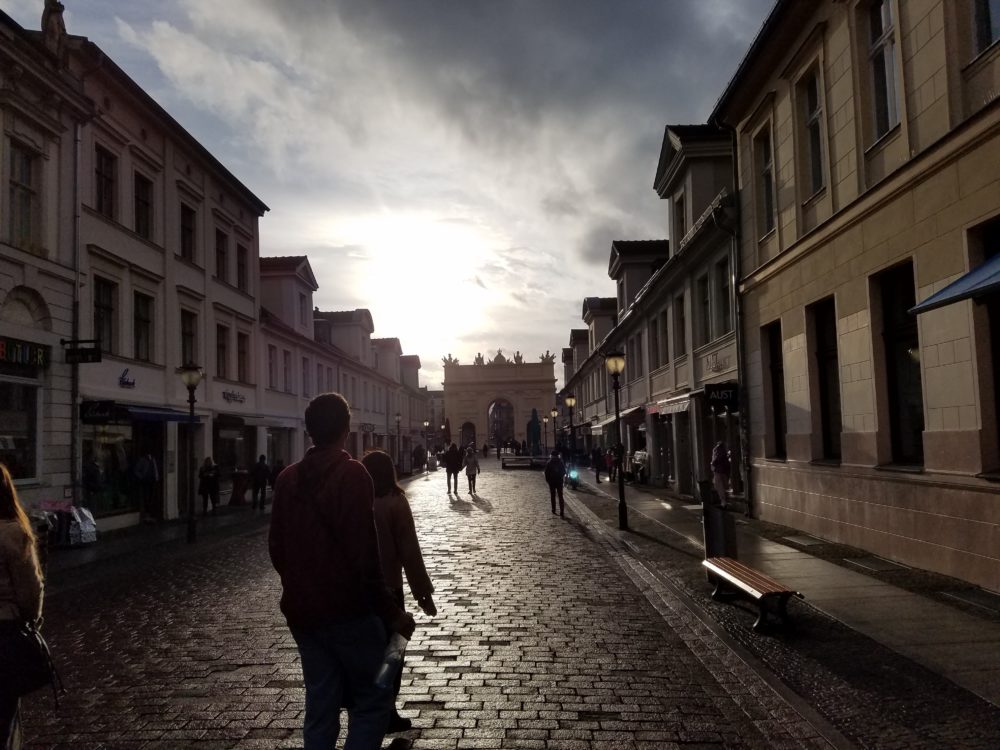
In spring 2019, Professor Elizabeth Drummond’s HIST 4273 Nazi Germany class traveled to Berlin, Germany for Spring Break as part of the BCLA Global Immersion courses initiative. While there, they visited museums, memorials, and a former concentration to examine how Germans have dealt with the history of Nazi Germany and the Holocaust. The following reflection is from a student in the course.
Reflection by Emily Massey, ’20, History major
Germany publicly presents its Nazi past through museums and memorials commemorating those who died at the hands of the regime and through educating people about the Nazi period. German Vergangenheitsbewältigung has, as N.S. Morris writes, “veered every couple of decades from an intense desire to forget unsavory memories to a regret-filled urge to reclaim and preserve them.” In the process of “coming to terms with the past,” accountability has always been accompanied by denial because of the desire to forget. During the initial postwar period, both East and West Germany presented themselves as victims. Selective memory tried to remove Germans from social responsibility for Nazi crimes. As Robert Moeller has described, there was relative silence because of the need to quickly construct a new civil society. It wasn’t until over a decade later, in the 1960s, that West Germany started to take some responsibility, and by the 1980s memorials and museums started to focus on the Holocaust specifically. Even today in Germany, there are still some difficulties in commemorating the victims of the regime, such as issues about political correctness and continuing conflicts about who represents the “other.” However, the city of Berlin, through the use of its many museums and memorials about the Nazi period, has created the sense of an inescapable obsession with the past that represents its history in both illuminating and uncomfortable ways.

The question of Vergangenheitsbewältigung asks: how do we deal with the past? How do we deal with our responsibility? How do we break out of the silence? What do you do with German suffering? This issue has played out in the public sphere in Germany. Using self-critical analysis, there was a widespread acceptance of guilt and responsibility across Germany after unification in 1990. Today, Germans study intensely about Nazism, and this education is reinforced by the practices of cultural commemoration throughout Germany. There are hundreds of sites of memory where Nazi crimes or Jewish life occurred. For example, I saw the Stolpersteine, or “stumbling stones,” around both Berlin and Frankfurt. These markers set into the sidewalks note where victims of the Nazis had previously lived. Without even trying to insert yourself into learning about or paying attention to the Nazi period, Germans have made sure that their representations about the past are ever-present and unavoidable.
One of the best representations and remembrances of the Nazi past in Berlin is the Jewish Museum, specifically because it does not simply focus on the Nazis and the regime. Rather, the museum presents the lives of the Jews who died because of the regime, as well as the lives of Jews today, and it provides reflective spaces where visitors can gain a sense of the sort of isolation and terror that Jews felt during that period of history. The Jewish Museum uses a new trend in museum design. It uses its architecture as a part of the museum, in addition to all the objects or lack of objects inside. Architecture shapes experience and keeps the wounds of the past visible. The spatial voids within the museum represent the absence of German Jews, symbolizing the German legacy of guilt. This museum not only educates visitors about murdered Jews and Jews today, but creates a physical interaction with the past through the use of its empty spaces. The specificity of the museum, as Jennifer Hansen-Glucklich has argued, also shows how Germany refuses to reduce Jewish history as merely a part of German history.

However, in my view, not all representations of the Nazi past are appropriate, specifically the Sachsenhausen concentration camp because of what it was used for during the war. While not a death camp, people still suffered and died at this labor camp. Rather than feeling like the camp was used for education or to memorialize victims, it felt like visitors went to the camp to simply stare at the horror that had occurred. It felt incredibly voyeuristic. I couldn’t understand if this place was meant to be a museum or memorial or both. But it felt like neither. However, places of destruction can be memorials. Memorials are used for family members, but also for future generations. They show the courage and glory of those who resisted or suffered under the regime. Still, memorials can also leave wounds unhealed. That was how this place felt, like a theme-park mass gravesite. At this place, people are only remembered for their deaths and not their lives, as James Young has discussed in his analysis of other concentration camp memorials. Nevertheless, I understand the importance of keeping a place like Sachsenhausen. Germans can never forget their past.
For further reading:
Hansen-Glucklich, Jennifer. Holocaust Memory Reframed. New Brunswick, NH: Rutgers University Press, 2014.
Moeller, Robert G. “The Third Reich in Post-war German Memory.” In Nazi Germany, edited by Jane Caplan, 246-266. New York/Oxford: Oxford University Press, 2008.
Morris, N.S. “The Soul of a City: Berlin and Memory.” Los Angeles Review of Books, 21 July 2016.
Young, James E. The Texture of Memory: Holocaust Memorials and Meaning. New Haven: Yale University Press, 1993.



